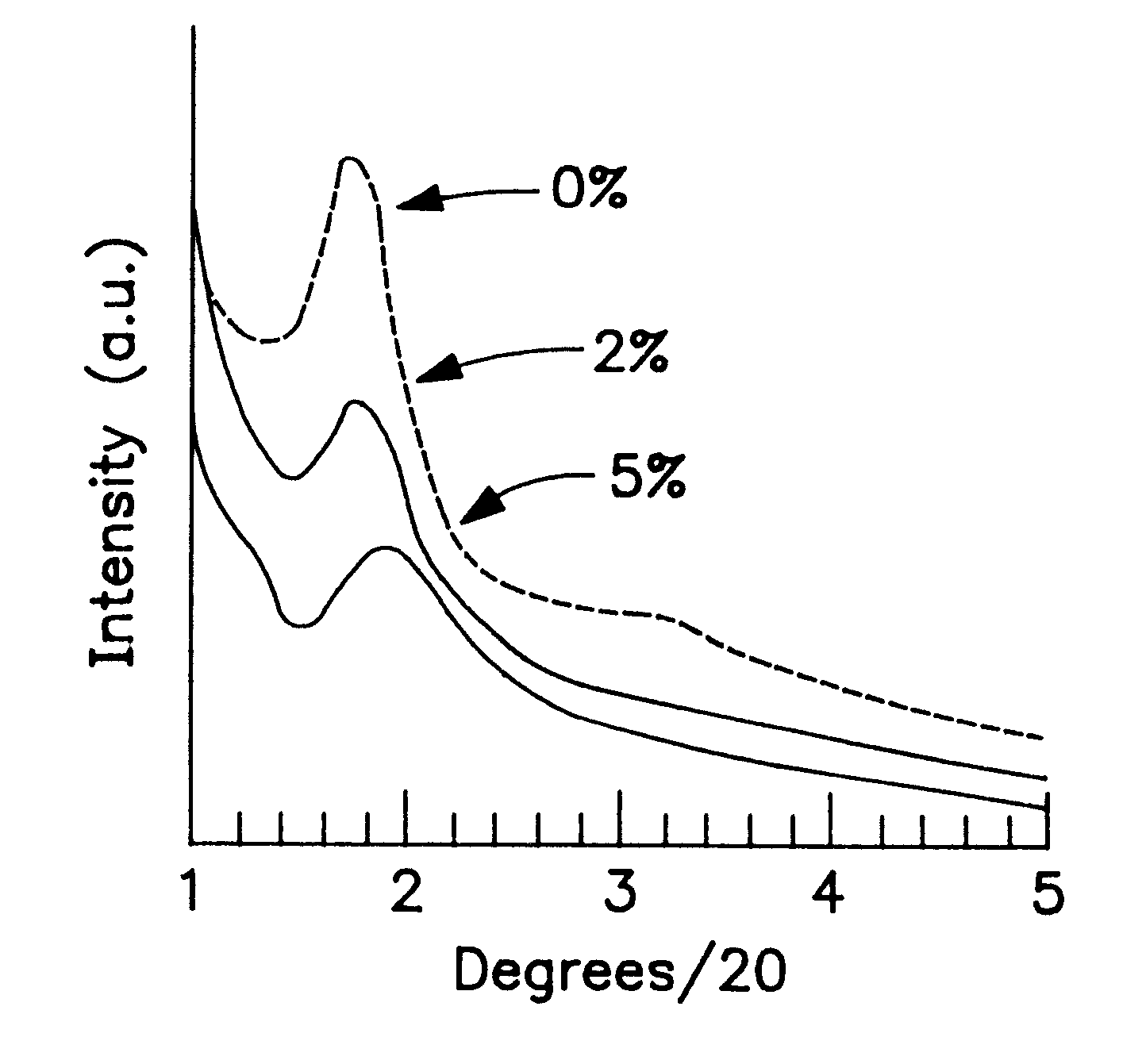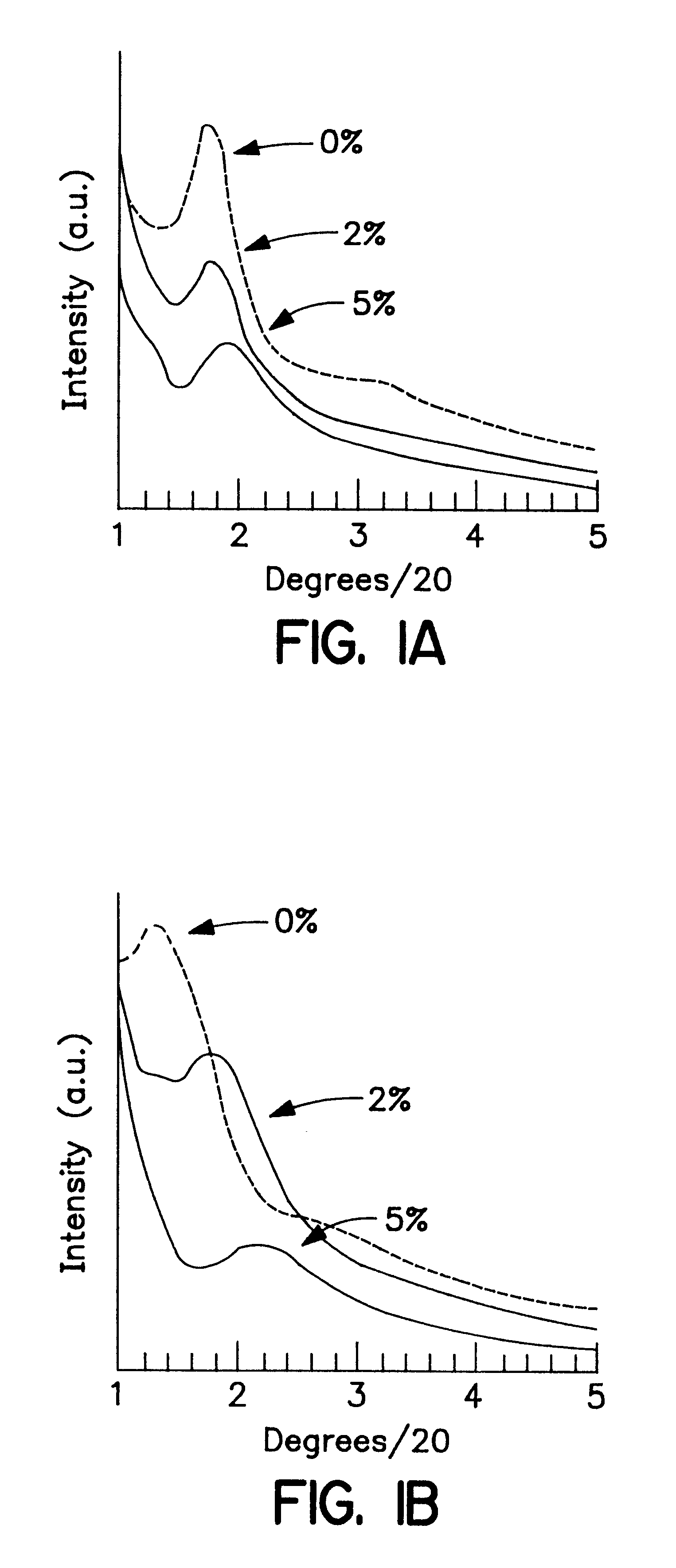Combined porous organic and inorganic oxide materials prepared by non-ionic surfactant templating route
- Summary
- Abstract
- Description
- Claims
- Application Information
AI Technical Summary
Benefits of technology
Problems solved by technology
Method used
Image
Examples
examples 1 and 2
The non-functionalized inorganic mesostructured silicas MSU-1 and MSU-2 were prepared according to previously published assembly techniques (Prouzet, E., et al., Angew. Chem. Int. Ed. Eng. 36, 516 (1997); U.S. Pat. No. 5,622,684), using TERGITOL 15-S-12 and TRITON-X, respectively, as structure-directing surfactants. Functionalized derivatives of MSU-1 and MSU-2 (MP-MSU-1 and MP-MSU-2) were synthesized by stirring TEOS and mercaptopropyltrimethoxysilane (MPTMS) in solutions of TERGITOL 15-S-12 (0.02 mol L.sup.-1) or TRITON-X100 (0.027 mol L.sup.-1) until a clear mixture formed. The solutions were then transferred to a thermostated water bath set at 308 K and NaF was added to catalyze the condensation of the siloxane molecules (the molar composition of each mixture was 0.1 surfactant: 1-x TEOS: x MPTMS: 0.02 NaF, where x=0, 0.02 or 0.05). After aging for 24 hours, the resulting powders were filtered, air dried and the surfactants removed from the mesostructure pores by Soxhlet extract...
example 3
Chloroalkyl functionalities have been successfully incorporated into mesostructured frameworks following the synthetic protocol described in Examples 1 and 2 as evidenced by XRD. These were prepared by stirring TEOS and chloropropyl trimethoxysilane in solutions of TERGITOL 15-S-12 (0.02 mol L.sup.-1) and TRITON-X100 (0.027 mol L.sup.-1) until a clear mixture formed.
Samples:
These were prepared following exactly the same protocol as that described in Examples 1 and 2, except that an equimolar quantity of chloropropyltrimethoxysilane was used as the organosilane agent instead of mercaptopropyltrimethoxysilane. The XRD patterns and N.sub.2 adsorption isotherm of the materials thus obtained were virtually identical to those of the mercaptopropyl (MP) derivative described in Examples 1 and 2. .sup.29 MAS-NMR and X-ray fluorescence measurements confirmed the presence of chloro groups in the samples in quantities similar to those of the sulfoxyl groups in the MP-derivatized analogs.
Another...
PUM
| Property | Measurement | Unit |
|---|---|---|
| Volume | aaaaa | aaaaa |
| Fraction | aaaaa | aaaaa |
| Fraction | aaaaa | aaaaa |
Abstract
Description
Claims
Application Information
 Login to View More
Login to View More - R&D
- Intellectual Property
- Life Sciences
- Materials
- Tech Scout
- Unparalleled Data Quality
- Higher Quality Content
- 60% Fewer Hallucinations
Browse by: Latest US Patents, China's latest patents, Technical Efficacy Thesaurus, Application Domain, Technology Topic, Popular Technical Reports.
© 2025 PatSnap. All rights reserved.Legal|Privacy policy|Modern Slavery Act Transparency Statement|Sitemap|About US| Contact US: help@patsnap.com



